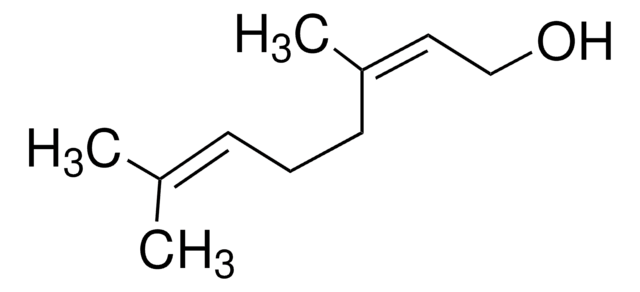W230901
Citronellol
≥95%, FCC, FG
Synonym(s):
3,7-dimethyl-6-octenol, Elenol
About This Item
biological source
synthetic
Quality Level
grade
FG
Kosher
reg. compliance
EU Regulation 1334/2008 & 178/2002
FCC
FDA 21 CFR 117
FDA 21 CFR 172.515
vapor pressure
~0.02 mmHg ( 25 °C)
Assay
≥95%
refractive index
n20/D 1.456 (lit.)
bp
225 °C (lit.)
density
0.855 g/mL at 25 °C (lit.)
application(s)
flavors and fragrances
Documentation
see Safety & Documentation for available documents
food allergen
no known allergens
Organoleptic
waxy; floral; rose
SMILES string
CC(CCO)CC\C=C(\C)C
InChI
1S/C10H20O/c1-9(2)5-4-6-10(3)7-8-11/h5,10-11H,4,6-8H2,1-3H3
InChI key
QMVPMAAFGQKVCJ-UHFFFAOYSA-N
Looking for similar products? Visit Product Comparison Guide
General description
Application
- A comprehensive assessment of the cholinergic-supporting and cognitive-enhancing effects of Rosa damascena Mill. (Damask rose) essential oil on scopolamine-induced amnestic rats.: The research highlights citronellol′s role in enhancing cognitive function and supporting cholinergic systems, indicating its potential use in developing treatments for cognitive disorders (Teralı et al., 2024).
Signal Word
Warning
Hazard Statements
Precautionary Statements
Hazard Classifications
Eye Irrit. 2 - Skin Irrit. 2 - Skin Sens. 1B
Storage Class Code
10 - Combustible liquids
WGK
WGK 2
Flash Point(F)
224.6 °F - closed cup
Flash Point(C)
107 °C - closed cup
Personal Protective Equipment
Certificates of Analysis (COA)
Search for Certificates of Analysis (COA) by entering the products Lot/Batch Number. Lot and Batch Numbers can be found on a product’s label following the words ‘Lot’ or ‘Batch’.
Already Own This Product?
Find documentation for the products that you have recently purchased in the Document Library.
Customers Also Viewed
Protocols
-(+)-Limonene, purum, ≥98.0% (sum of enantiomers, GC); Geranyl tiglate; α-Terpineol, natural, ≥96%, FCC, FG; Geranyl formate; α-Pinene
-3,7-Dimethyl-2,6-octadien-1-ol; Neral; Geraniol; Geranial; Undecanal; Citronellyl acetate; Neryl acetate; 3,7-Dimethyl-2,6-octadienyl acetate; 1-Tetradecene; Tetradecane; α-Bisabolol
Our team of scientists has experience in all areas of research including Life Science, Material Science, Chemical Synthesis, Chromatography, Analytical and many others.
Contact Technical Service


